IDEX Online Research: U.S. Jewelers Finish Strong in 2009, After Weak Beginning (Full Analysis)
February 17, 10
Specialty jewelers’ sales surged in December 2009, according to the latest data from the U.S. Department of Commerce. In part, the sharp percentage gain in specialty jewelers’ sales is due to last year’s disastrous declines. It is also due to a return to the malls by American shoppers who were flexing their spending power, after exercising uncharacteristic restraint for more than a year.
However, despite strong sales during the final months of 2009, specialty jewelers posted a modest decline in sales – down 3.9 percent – for the full year. The table below summarizes results for U.S. specialty jewelers and other merchants who sell jewelry as well as total U.S. retail sales. We note that government data continues to be revised; thus, some of the numbers on the table below may differ from earlier reports.
|
Despite an extremely weak start to 2009, jewelry demand improved as the year progressed, and finished on a high note. While it is likely that December data will be revised – probably downward – the underlying fundamental trend will still reflect a double-digit sales increase, in our opinion.
Both specialty jewelers and other merchants who sell jewelry reported that sales strengthened throughout the year, though there was some month-to-month variation in sales levels. There appeared to be an inflection point at the end of the summer. By then, economic forecasts were more bullish, and the stock market had posted gains for a number of months. While the real estate market remained mired in mud and unemployment continued to climb, American consumers could see the “beginning of the end” by August or September 2009. At that point, they began loosening their purse strings. Jewelry sales, along with total retail sales, began to show notable improvement.
The graph below summarizes monthly sales trends for both specialty jewelers as well as all merchants who sell jewelry. As the graph illustrates, specialty jewelers’ sales gains lagged total industry sales gains, but both moved directionally together as the year progressed.
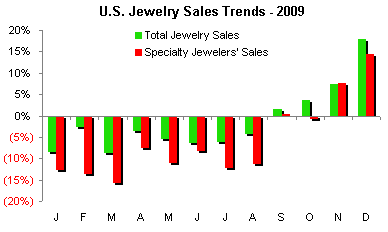 Source: Dept of Commerce |
Jewelry Sales Stronger Than Total Retail Sales
It is no surprise that jewelry sales have recovered much more strongly that total retail sales. In part, this is due to the inherent cyclicality of jewelry sales: they dipped much further on the way down, and now they are rising much faster on the way up. However, it also relates to consumer attitudes: shoppers are ready to spend a little money on luxury goods, after a buying hiatus of more than a year.
The graph below illustrates total jewelry sales trends versus total retail sales trends.
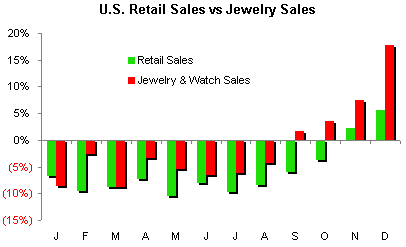 Source: Dept of Commerce |
The following table summarizes monthly jewelry sales for the past three years.
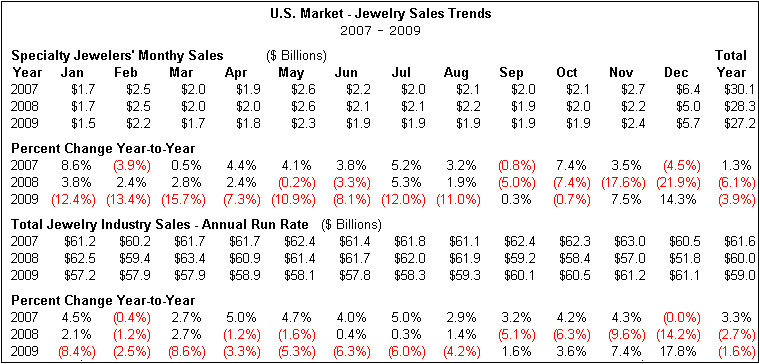 |
Key Factor Fueling Jewelry Sales – Americans Love to Shop
Why were jewelry – and retail – sales so strong at the end of the year? It all has to do with the American shopper. Here are some reasons:
· Americans love to shop. They are born to shop.
· Americans shop for recreation, for something to fill their time.
· After reining in their spending for more than a year, American consumers were ready to shop. There was significant pent-up demand which emerged in the 2009 holiday selling season.
· Most merchants offered great deals which enticed shoppers into the malls.
Key jewelry sales trends from the 2009 holiday selling season include the following:
· The average ticket for a piece of jewelry was down by 8-10 percent. Merchandise offered at lower price points sold best.
· There were plenty of consumers who wanted to buy jewelry, based on store traffic counts.
· Jewelry sales improved as the season progressed.
· Specialty jewelers lost market share to discounters and other merchants who made a strong “value” statement.
Before the Celebrations Begin ...
While jewelry sales were up in the 2009 holiday selling season, they are still well below levels achieved mid-decade. In the 2009 holiday season, jewelry sales levels were about the same as in 2002.
The graph below summarizes specialty jewelers’ sales during the all-important November-December holiday selling season for the past 18 years.
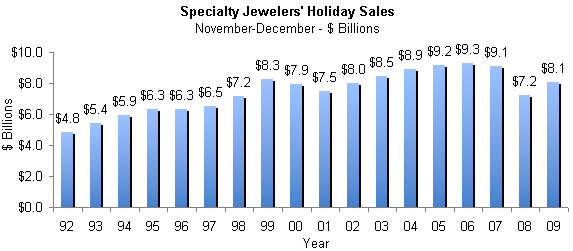 Source: Dept of Commerce |
Importance of
In 2008, sales from the all-important holiday selling season represented a mere 25 percent of specialty jewelers’ yearly sales, down from nearly one-third of annual sales historically. In 2009, November and December sales were about 30 percent of a specialty jeweler’s annual sales. We believe that November-December sales will continue to rise to about one-third of a jeweler’s yearly sales as the market recovers to normality.
The graph below illustrates the percentage of total annual specialty jewelers’ sales represented by November and December revenues.
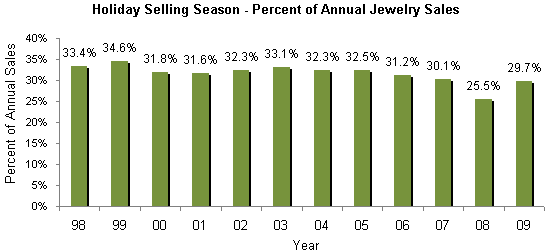 Source: Dept of Commerce |
2009 Annual Jewelry Sales Fall Below 2008
Aggregate jewelry sales for specialty jewelers during 2009 dipped below 2008, which was one of the worst years on record. While sales perked up notably in the final months of 2009, they were substantially depressed for the majority of the year.
The graph illustrates annual sales for specialty jewelers for the past 18 years.
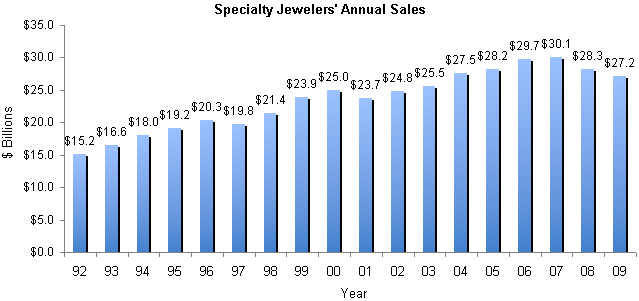 Source: Dept of Commerce |
Outlook: Continued Solid Sales Gains in 2010
Politics aside, the U.S. took steps early in the economic chaos to abrogate the impact of the Great Recession, and it was successful. Once again, doomsday-sayers have been proven wrong. Fourth quarter GDP rose by a preliminary 5.7 percent. The
In an environment of economic growth, consumers will buy jewelry, and they proved this during the 2009 holiday selling season. Many forecasters have predicted a “new normal” for shoppers who will focus on lower-priced goods. While we can’t argue with that, there are still plenty of shoppers who can buy expensive jewelry.
Our preliminary forecast for 2010 calls for specialty jewelers’ sales to rise by about 4 percent or so. This would yield annual sales of about $28.3 billion, roughly in line with 2008 sales levels, but still well below 2006 and 2007 sales.